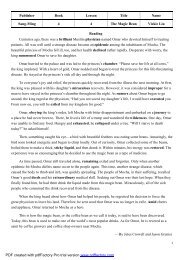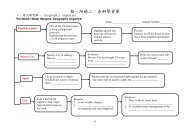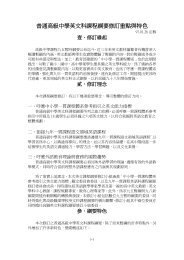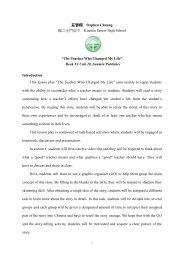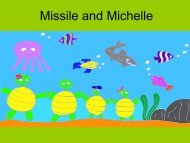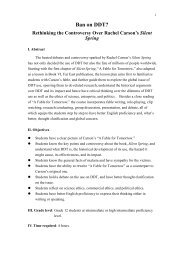Reading
Reading
Reading
You also want an ePaper? Increase the reach of your titles
YUMPU automatically turns print PDFs into web optimized ePapers that Google loves.
Students’ production:II. Presenting the TextDirections: in this part, exercises are designed to guide students into writingthrough careful reading of the lesson.(A) Listen as a writer: the teacher asks students to listen to the target lessonon the CD carefully. By using the story map, students should:1. Write down the main characters in the story.2. Write down the problems from the story.3. Write down the solutions to their problems.4. Write down the outcome of the story.Story MapWho (Who was in the story?)→Where (Where did the story take place?)→When did it happen?→What was the main character’s problem?(A) Joe’s→(B) The old lady’s→
(C) Joe’s wife’s→How were their problems solved?(A) Joe’s→(B) The old lady’s→(C) Joe’s wife’s→(B) StorytellingDirections:1.The teacher may divide the students into groups and ask them to take turnsretelling the story “The Chain of Love” to their group members when lookingat the related pictures.2.The teacher can also arrange students in a circle and pick one student tostart the story with one or two sentences. Students continue around thecircle with each person adding another sentence or two to the story until allthe main parts of “The Chain of Love” are covered.(C) Rewrite the story1. Translating: by translating some parts of the text, students willunconsciously perceive the sentence patterns, worthy ideas, a model ofgood writing, and gradually they can improve their fluency of expression.Procedure:(1) The teacher underlines the sentences for students to translate.(2) Students are required to write down their translations of the sentences. Indoing so, students are compelled to read the original text thoroughly and
carefully observe the sentence structures and the authentic usage of everyword.Example (The second paragraph):The afternoon was slowly fading into twilight. (1) With the continuoussnow flurries making it difficult to see, he almost missed the elderly ladystranded on the side of the road. Fortunately, even in the dim light of day, hecould see she needed help, so he pulled up in front of her car and got out. (2)這 位 女 士 緊 張 地 微 笑 , 顯 然 很 擔 心 _________________________________ “(3)除 了 這 個 人 , 過 去 好 幾 個 小 時 , 都 沒 人 停 下 車 來____________________________ He looks poor and hungry. Is he going tohurt me?” she thought to herself.2. ParaphrasingProcedure:(1) The teacher can select one or two paragraphs for students to paraphrase.(2) The teacher asks students to read the paragraphs until they are sure of themeanings of every word and every sentence.(3) In paraphrasing, students do not have to find a synonym for every word ifthe word is simple. That is, they simplify unusual words or figures ofspeech but keep those words whose meanings are clear.(4) The teacher should encourage students to use a dictionary when doingparaphrasing.Example (The tenth paragraph):Original:The lady finished her meal and quietly slipped out of the door while thewaitress was getting the change from the hundred-dollar bill the lady had givenher for the bill. When the waitress returned, the lady was no longer in sight.On the table was a napkin, with four more one-hundred-dollar billsunderneath it. The lady had paid almost fifty times as much as the cost ofher meal! Tears filled the waitress’s eyes as she read what was written onthe napkin. It said, “Someone once helped me out in the way I’m helping younow. If you really want to pay me back, don’t let the chain of love end in yourhands.”Students’ production 218 11 號While the waitress was getting the change from the hundred-dollar bill thatthe lady had given her for the check, the lady finished her meal and quietlyleft. When the waitress returned, she could see the lady nowhere. There
surprising gift, the waitress was moved to tear.End →Arriving home, the waitress lying on the bed thinking about whathad happened. She took a look at her husband who was sleeping andsaid,’’ Everything will be all right. I love you, Joe.”4. Writing a different ending: this is another way of asking students to followthe original story plot but meanwhile exercise their imagination to addsomething new of their own to the story. The teacher can ask students towrite a new ending paragraph to replace the original one. Judy Huang onceused a very clear way to ask her students to write a twist ending for a story.Firstly, she introduced the nine types of stories (romance, adventure, thriller,comedy, tragedy, science-fiction, Western, fairy tale, and martial arts) to herstudents. Then she wrote down the nine types of story on slips of paper.After that, her students were asked to write a twist ending based on the typeof story they drew.5. Writing a journal entry: students write about this encounter from the lady’spoint of view, or Joe’s point of view. They might begin the story by “Onefoggy evening …” or “Being laid off, I drove back home…..” This kind ofwriting can let students be one of the characters and re-tell the story fromthe character’s point of view. Having read the story several times, studentswould unconsciously use the vocabulary or sentences they have acquiredfrom the story in their rewriting process.Students’ production 218 10 號 (From the old lady’s point of view)It was a snowy afternoon. Unfortunately, my car broke down in this terribleweather. It was getting darker and darker. Many cars had passed by butnone of them stopped to help me. As an old woman, the chilly wind made mefeel extremely cold. All of a sudden, a car pulled over. A man got out of hiscar, walking toward me. Initially, I was very nervous. He looked poor andhungry. Was he going to hurt me? On the contrary, he just introducedhimself then quickly fixed my car. His name is Joe. My heart was full ofgratitude. I asked Joe what he wants for repay. To my great surprise, Joemerely asked me not to let the chain of love end in my hands then left.On my way home, I was so hungry that I stopped in front of a smallrestaurant. A waitress walked out with a towel for me to dry my hands. Herwarm smile illuminated the dim light in the restaurant. She was heavilypregnant. Nevertheless, her sweet smile couldn’t be wiped even if she hasstood for all day long. I wondered who on the earth can help others in such akind way but ask for no repay. Then I remembered Joe. Why did a pregnant
woman like her have to work so hard? She must have had some financialproblems. I made up my mind immediately after I realized it. So, I slippedout the restaurant while the waitress went to get my change. I left fourhundred dollars for her. Imitating Joe, I wrote a message on the napkin,asking her not to let the chain of love end in her hands. I knew that the chainof love could last for a long, long time.6. Imitating: using the lesson as a model, students are asked to expand theirwriting experience by imitating one or two paragraphs from the selectedpassage. This method can equip students with abilities to write authenticallyby asking students to follow the original text and meanwhile write their ownsentences. When the teacher conducts the writing task, it is recommendedthat students write based on a sequence of pictures.Procedure:(1) The teacher selects one or two paragraphs worth imitating.(2) Students are required to read the paragraph(s) several times and then putaway their textbooks.(3) Students are encouraged to complete the worksheet based on the picturesprovided.(4) Students can choose to write their own sentences or adopt sentences fromthe target lesson. (It should be noticed that when writing the passage,students are not allowed to look at the target lesson.)Worksheet for ImitatingName________ No________ Class__________Score:_______Fill in the blanks with appropriate words, phrases or sentences:It was starting to get dark, I was _________________________________.When I got on the bus, __________________________________________.I almost missed the _________ man, who_______________. Fortunately,Even in the dim light of day, I could see he_________________. SoI__________________________________________________________.The man smiled nervously, looking visibly ___________.
Realizing that ____________________________________, I saidquickly, “__________________________________________________.”All he needed __________________________________________, but for_____________________________________, that was bad enough. Whilehe ___________________________, I began to talk to him. I told himthat_____________________________________. He thanked him forcoming to his aid. I ____________________________________________.He asked me how________________________________________. Hesaid _____________________________________ if I had not helped him.To me, It wasn't a _________________ but _____________________.I told him,” If you really want to pay me back, ______________________________________________________.”
Students’ production 218 8 號Worksheet for ImitatingName________ No________ Class__________Score:_______Fill in the blanks with appropriate words, phrases or sentences:It was starting to get dark, I was waiting for the bus No. 33 at the busstop near Wen-hua. Beside the bus stop, a man had waited there.When I got on the bus, I found a seat to sit on. I almost missed the poorman, who forgot to bring some coins to pay for the ride. Fortunately,Even in the dim light of day, I could see he was embarrassed. So I quicklyasked the man if he needed any help. The man smiled nervously, lookingvisibly upset.Realizing that he felt uncomfortable, I said quickly, “I can help you.”All he needed was twenty dollars, but for a man like him, that was badenough. While he was standing beside me, I began to talk to him. I told himthat I am studying in Wen-hua and a woman helped me out last week inthe way I helped him. He thanked me for coming to his aid. I said, “Nevermind!” He asked me how he could return the money to me. Hesaid he would have been very embarrassed if I had not helped him.To me, It wasn't a big deal but helping someone in need. I told him, “Ifyou really want to pay me back, don’t let the chain of love end in yourhands.”
III. Bridging Practice to WritingDirections: the following exercises are designed to help students get familiarwith the narrative writing. Besides the sequence of the event and propertense to describe the event, while writing a narrative, students should alsoknow how to make good use of transitions, adverbs, adverb phrases,subordinators, and prepositional phrases.Adverbsnow, then, at that time, one day,SubordinatorsPrepositional phrasesTransitionslast night, yesterday evening,as, when, while, after, before, until,as soon as, the moment when,from then on, in the end, in thebeginning, in front of, at a distance,close to, next tofirst, second, next, after that,afterwards, later, soon, however,therefore, instead, meanwhile(A) A personal narrative: an annoying experienceProcedure:(1) Students write an outline by using the following graphic organizer whichincludes the 5W1H in a narrative.(2) The teacher reminds students to write a clear topic sentence and aconcluding remark.(3) After the writing, students re-examine their story and again put properadverbs or transitions in their story.
(B) A biographical sketch: a biographical sketch is a shorter version of abiography. Writing a biographical sketch is like writing a story. Thequestioning techniques (the 5W1H ) used in story writing can also be found ina biographical sketch.Procedure:(1) Students draw a life span of themselves, or a person they know.(2) Based on the life-span graphic organizer, they write a biographical sketch.(3) After the writing, the teacher needs to remind students to double-checktheir tenses and add proper adverbs and transitional words.(C) A book report: to write a book report of a novel is like writing a condensedversion of a story except that it may involve more characters, more settings,and more details of the plot. Besides the summary of the story, students canalso write about their response to the story or a character they like most.Procedure:(1) Students choose a book they wish to write about.(2) By using the following chart, they write a condensed version of theStory, their response to the story and the character they like most.(3) After the writing, the tense agreement and proper subordinators and transitionsshould be re-examined.
My Book ReportName________ Class_______ No________Title:_________________________________________________Author:_______________________________________________Summary of the story:____________________________________My own response to the story:______________________________Illustrations of the story:___________________________________The character I like most is ________________________________IV. Students’ Works(A) A personal experience: An Annoying Experience 218 27 號I had an annoying experience when I was a junior high school student.One day, when I finished shopping and walked out of the supermarket, at thatvery moment, the alarm went off suddenly. I felt very embarrassed while ashop clerk was coming to me. He talked to me in an offensive way, warningme to confess what I had stolen from the store. Before long, they found outthat their machine had some trouble. Then, they apologized to me and gaveme some coupons.After experiencing this uncomfortable situation, I learn that I should notjust do nothing if I encounter something annoying; instead, I should fight formy rights. I also learn that no matter what happens, I should talk to others inan appropriate way; otherwise, the misunderstanding will get worse.(B) A biographical sketch 114 24 號I was born on May eighteenth 1984. When I was seven, I won a prize inarts. Everyone in my family thinks I am a genius. However, a bad thinghappened when I was eight years old. My mom made my hair like “LittleSweet 2.” When I was ten years old, for the first time, I went to Hong Kongwith my mom and my sister. That was a beautiful memory in my mind.From then on, I tell myself to save money to travel around the world.When I was sixteen, luckily, after many months of study, I successfullywent to the best senior high school in Taiwan. But a few days later, a bigearthquake was happened. It was so horrible that I will never forget it. Now,I have many friends and am very happy. I will value our friendship forever.
(C) A book report 218 12 號My Book ReportName________ Class_______ No________Title: Howl’s moving castleAuthor: Diana Wynne JonesSummary of the story:The story started with Howl’s castle approaching to the town. Sophie was theeldest daughter of the Hatter’s family, and was considered to be the worse.She somehow offended the witch of the waste, and was spelled into a ninetyyear-old woman. Because of being spelled, Sophie escaped from her home,and chose to hide in Howl’s moving castle. There, she met Michael- a youngman learning magic from Howl, Casifer- a fire demon who provide power andheat to the moving castle, and Howl- the magician of the moving castle. Shefell in love with Howl and overcame the difficulties they met. The lovebetween she and Howl removed the curse on her and Howl, and they livedhappily ever after.My own response to the story:I personally love this fiction. Actually, I had viewed its animation versionbefore I came to the novel class. I appreciate Sophie’s courage to fightagainst all the evil things, and I also like the Howl’s transformation from acoward to a braver man. The part when the love between Howl and Sophiebroke the curse on them was my favorite part. I was moved to tears.The character I like most is Howl. He seems to be strong, but actually, he isa coward. He is afraid to face the witch of the waste, and tries his best toavoid her. To pursue a higher level of magic, Howl takes his soul to changefor those magic powers from Casifer. He escapes and escapes. He would doanything to avoid danger. Howl seems to like all women, but he does not. Ashis soul is taken by Casifer, he can not fall in love with others. You may seeSophie as an exception. Howl’s falling in love with Sophie breaks the curse,and saves his own life.
V. ConclusionOften in EFL classrooms in Taiwan, the problem of writing has been greatlysimplified by providing the students with ideas to write about a subject. Inwriting class, which might start from the second semester in the second grade,topics are given along with the discussion of the ideas about to be included intheir composition.This is how an original composition comes out.Nonetheless, the problem a writing teacher encounters is that students, unlikenative speakers, may not have the ability to make good use of their linguisticknowledge, and they are often found not expressive when using English.Namely, they are not capable of writing authentically. The above lesson planfocuses on, first of all, students’ rewriting the author’s thoughts. The rewritingprocess provides students with a chance to remember the most importantparts of the story.In doing these exercises, students can enlarge theirvocabulary, refine their diction and most of all, would have a basic idea of howa good narrative is written.Besides, they can also cultivate their capabilitiesto re-construct the story based on the main plot and the words or sentencesthey have acquired from the story. The second part of the lesson plan, thefollow-up writing practice, on the other hand, helps to guide students intohaving different kinds of narrative writing experiences and the expressionsrelated to time order of events are stressed here. It is hoped that via theabove methods and exercises, students will know more about narrative writingand will be more expressive when writing English composition.Source: I must credit Robert M. Gay with the idea of rewriting or retellinganother person’s thoughts through the process of translating, paraphrasing,condensing and imitating.Though I have taken small liberties with theprocedures and exercises, and created a new lesson plan of my own based onthe target lesson I selected, the core ideas and techniques are his, not mine.To learn more, read Robert M. Gay’s book Writing Through <strong>Reading</strong> (Boston:Atlantic Monthly Press, 1921)



